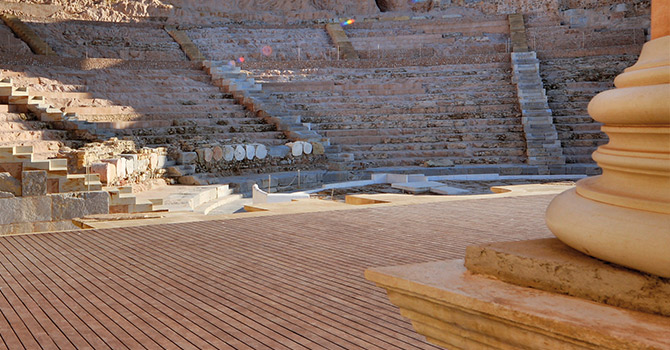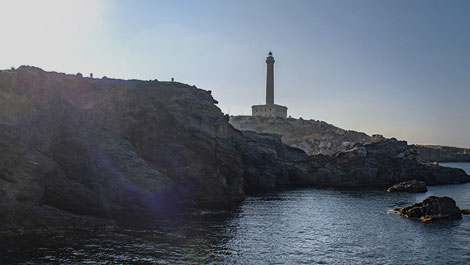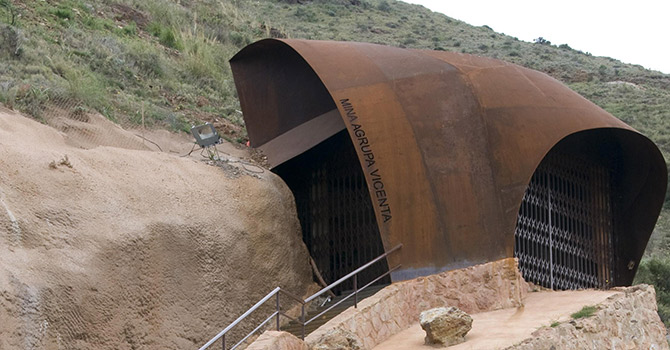If the visitor starts his journey along the coast of Cartagena from the west, he will come across the villages of Isla Plana and La Azohía, which, with their large sandy beaches and mountain views, are traditional summer resorts. La Azohía has a beautiful polygonal defence tower from the 16th century and is famous for tunny fishing, an age-old art practised by the Arabs. Beyond La Punta de la Azohía, the coast changes to cliffs, with solitary beaches such as Cala Cerrada and Cala Abierta, excellent places for bathing, accessible by sea or by walking down paths, ideal for those who enjoy both active tourism and peace and quiet. After rounding Cabo Tiñoso, an excellent vantage point at an altitude of over 300 m, the traveller reaches an area of virgin coast, dominated by the Mountain Range of La Muela, which has been protected as a result of its high natural value. This area contains the fishing village of El Portús, with its nudist camp site.
To the east of Cartagena, there are different landscapes which include the Regional Park of Calblanque, a privileged area of the coast of Murcia. It has a wealth of species of fauna and flora, with geographical formations as varied as coves, large beaches, fossil dunes, salt flats and mountain slopes, with various routes for visiting the park. Further on are the protected coves of Cala Flores and Cala Reona, near to Cabo de Palos. This area, which also includes the surroundings of Islas Hormigas and Isla Grosa, is especially interesting for divers due to the fauna and flora that live on the rocky sea bottom.
Top 10
Cartagena, with more than 3,000 years of history, has been the scene of some of the most outstanding passages throughout time. This Punic, Roman, military and art nouveau city offers nowadays so many things to see and do that it has become one of the most appealing destinations in the Mediterranean area.
MILLENARY HISTORY
On the top of one of the five hills of the city, in the Concepción Castle, is a good -possibly the best- starting point to visit this millenary city: the Interpretation Centre of Cartagena's History. Three thousand years of knowledge and history, together with the heritage from the most relevant civilisations from the past, in an hour's visit.
ROMAN THEATRE
The Roman Theatre Museum is the city's undeniable symbol. It is a wonderful architectural ensemble, designed by Rafael Moneo, where every space is even more amazing than the previous one. It integrates Pascual Riquelme Palace, Santa María la Vieja Cathedral and, after the last corridor, the Roman Theatre, which is the most impressive part. An interesting detail: Carthago Nova Theatre, built in the 1st century BC by Emperor Augustus, was not discovered until 1990.
FEEL LIKE A ROMAN CITIZEN
If you enjoy reliving history and stepping over the floor on which some important events took place in the past, you will feel like a child in the old Carthago Nova's Roman Forum district. It is a real privilege to visit this site, hidden underground for more than 20 centuries, where the thermal complex and the atrium building stand out. If you come with your family, we recommend dramatised visits.
SEA TREASURES
The Underwater Archaeology National Museum houses the famous 'treasure of Nuestra Sra. de Las Mercedes frigate', a booty including 570,000 gold and silver coins from the 18th and 19th centuries. The visit also includes many other elements which are maybe not as well-known but quite as valuable. We suggest you discover them step by step and then 'digest' the whole experience at the museum's restaurant, at a restaurant at the port, or at Santa Lucía fishing district. If you keep wanting more, the Naval Museum is another interesting visit; its most outstanding parts are the exhibitions on navigation and shipbuilding and Isaac Peral Hall, where you will see the famous submarine which has been the symbol of this port city for more than 80 years.
BOAT RIDE
This boat ride will take you to the most haunting spots in the inner harbour, bordering the bay's fortifications. By admiring this wonderful view, you will be able to feel like general Scipio Africanus and imagine what he saw before the landing which made him conquer the old Qart Hadast. The itinerary includes a visit to the Centre of Interpretation of Cartagena's Defensive Architecture, where you will learn about history and legends of both the trade and military role played by this Mediterranean junction for more than 2,000 years of history.
A CHARMING BEACH
Cala Cortina is Cartagena's urban beach. To get to it you just need to go through a tunnel and there you go! A wonderful Mediterranean cove will appear in front of you, with children's play area, seafront promenade, restaurant, loungers and sunshades. Besides having a refreshing swim, you can dive and enjoy the area's underwater life.
HIKING OR DIVING?
If you're keen on hiking, the PR-1 route will take you from Cala Reona to Calblanque: an easy walk at the end of which you should definitely have a swim in the crystal clear waters of this nature park's beaches. You will need a cap, a pair of binoculars and a camera. Essential stops are Playa del Portús and Cabo Tiñoso, since the beauty and diversity of its seabeds have turned this area into one of divers' favourite destinations. You will like it so much that you won't feel like rising to the surface, but... Don't worry. When you do, you will be able to admire the magnificence of one of the Southeast's most important ecological landscapes.
FESTIVITIES AND FESTIVALS
Among Cartagena's many different treasures, one of them is irresistible: its Holy Week. The Passion Week in Cartagena has been declared to be of International Tourist Interest. Its processions are hypnotic due to the rhythmic movement of thousands of hoods and the polychromy created by flower ornaments and small lamps, an effect that is even more impressive in the small hours. If you arrive in summer, we have a special suggestion for you: spend the day at Calblanque idyllic beach, and the evening at La Mar de Músicas festival in Cartagena, where you will enjoy art and musics of the world. And remember: the scenes are placed at strategic spots by the Mediterranean seaside with amazing views.
UNDER THE LIGHTHOUSE
On Sundays, the street market takes place in Cabo de Palos, a picturesque fishing village next to La Manga del Mar Menor and less than 30 minutes away from Cartagena by car. Walking about the stalls, finding some bargains, enjoying the sea atmosphere and tasting a typical, delicious caldero rice dish -a fish rice dish cooked in a pot- at Paseo de La Barra, in front of the sea, is a perfect plan. Our advice: follow the seafront promenade and you will get to this locality's impressive lighthouse, which used to be a lighthouse-keeper school and is one of the best places to stare at the skyline by the Mediterranean.
DELICACIES
Any time is a good time to pamper the palate. Typical from Cartagena are grilled fish, roast fish or fish baked in salt, michirones, the famous caldero rice dish, and rabbit, either with rice or ajo cabañil. The most typical salad is the cantonal salad made with smoked fish, including salmon, cod and harvestfish, together with capers, onion and olive oil. As a dessert: melon, prickly pear, arrope and tocino de cielo. To top it off, the famous asiático coffee, made with condensed milk and a little Licor 43, cinnamon, lemon peel and several coffee beans. The asiático cup is so original that it has become one of Cartagena's most singular souvenirs.
Top 10
La Unión is located very close to the Mar Menor and Mediterranean Sea beaches. Its culture and landscapes are firmly linked to over 3,000 years of mining activity and flamenco, forming one of the Region of Murcia's destinations with more personality.
I AM A MINER...!
Do you want to live striking experiences? Well, come and see... because there are few places as spectacular as the La Unión Mining Park, a mining complex of 50,000 square metres, where you will discover "in situ" the whole process of the 19th and 20th century mining industry and go through the Agrupa Vicenta Mine tunnels at a depth of over 80 metres and one of the biggest mines open to the public in Europe. An impressive experience are the giant tunnels, the underground lake of reddish waters by the pyrite effect, and the flamenco performances that take place inside. Can you imagine how a concert must sound down here?
FLAMENCO WITH "DUENDE"
La Unión is the fixed residence of the best magical flamenco. The Cante de Las Minas International Flamenco Festival is declared of International Tourist Interest and also considered as one of the most important festivals in the world. Here you will enjoy the most acclaimed artists and candidates' performances who covet the award "Lámpara Minera", in sessions that don't end until early morning. If flamenco is in your blood, welcome, you are in one of its epicentres.
GO STRAIGHT TO HEAVEN
Due to its imposing and monumental appearance, Nuestra Señora del Rosario Church is considered as "The Cathedral" of Sierra Minera mountain range, and it is declared a Site of Cultural Interest. Inside, you will find the municipality Patron Saint, sculptures of the Holy Week that are declared of Regional Tourist Interest, and one of the most popular sculptures in the town: the Cristo de los Mineros (The Miners' Christ), protagonist in the Holy Thursday Procession.
LIVELY MUSEUMS
The Cante de las Minas Museum is located on the ground floor of Casa del Piñón, and is a sensory museum, where you will relive the most outstanding performances of the Cante de Las Minas International Flamenco Festival. There you will have the opportunity to peek into the miner's reality and their hard life circumstances, which enabled the flamenco songs' birth. We assure you that you will get goose bumps. The Mining Museum that is also located in Casa del Piñón is a point of reference in the Spanish mining history. Among the most interesting items, you will find mining tools, scale models, several rooms dedicated to miners and their lifestyles and an excellent mineral collection. Visiting it is one of the best ways to jump into the municipality identity and also, to pay tribute to the brave miners who risked their day-to-day lives going down into the mines.
A JOURNEY TO THE ROOTS
The Ethnographic Museum located in the district of Roche, proposes to give you a fresh twist on your knowledge about the mining world. Utensils on display behind these showcases bring you closer the daily life of the ancient inhabitants of La Unión. Part of the permanent exhibition are: glass relics, weights and measures instruments, esparto grass containers, ceramics, agricultural tools, traditional costumes and ancient lighting systems, such as the "velero", "churro" or the oil lamp. Moreover, next to this room is the Interpretation Centre of La Unión.
GETTING TO KNOW THE PAS
We recommend you to take a break and go to the Archaeological Museum in Portmán, located in the Ancient Charity Hospital, where injured miners of mining accidents were looked after. Items from different historical periods are exhibited here: from the Roman times, when more than 40,000 slaves worked in those mining sites, until the 20th century. The biggest and best-preserved collection of Roman mosaics in the Region of Murcia stands out among the museum treasures.
MINING PASSION
Perhaps a special religious feeling began in the men of La Union due to having spent half of their life in underground tunnels. If you have the privilege of visiting La Unión during Holy Week, declared of Regional Tourist Interest, you will find face to face with this feeling. It is essential on the Saturday afternoon before Easter to go to the Processional Via Crucis of the Cristo de los Mineros (the Miners' Christ), which is carried on shoulders and travels down from Agrupa Vicenta Mine to Nuestra Señora del Rosario Church and to the Certamen Nacional de Saetas del Miércoles Santo (a flamenco style sacred song contest on Holy Wednesday). Go to the Holy Week Museum to complete your experience; there you will find the essence of the mining processions in the same place.
TREASURE HUNTER
If you're into natural sciences, here you have one of the most important events in Spain related to this exciting world: the National Fair of Minerals and Fossils. It takes place inside the Antiguo Mercado Público coinciding with Holy Week, and it brings together many amateurs and professionals who take the opportunity to carry out exchanges and sales of stones from all over the world, and even from meteorites. The genome of the Universe at your fingertips.
THE CATHEDRAL OF "CANTE"
The Antiguo Mercado Público, completed in 1907, is one of the most outstanding works of Modernism in the Region of Murcia. Its spectacular iron and glass structure, as well as its size, are due to the prosperous years La Unión lived in the early 20th century, thanks to its lead and silver mines. Currently this space is no longer used as a market, but geared to cultural and artistic events, serving as a venue for The Cante de Las Minas International Flamenco Festival, and because of that, it is also known as the Cathedral of "Cante". You will be surprised by its lighting and amazing acoustics.
PORTUS MAGNUM
Portmán is the La Unión façade to the Mediterranean Sea. Its close location to the mines of the Sierra de Cartagena mountain range and La Unión made it a strategic port for the ancient Romans, who named this area as Portus Magnum. In the surroundings you will find the remains of mining operations and facilities for the mineral smelting of that time and the 19th century. The beaches of this area that are quiet and secluded, have become places of worship for photographers who come to capture the dramatic contrasts that occur among the multicoloured sand, sea and sky. If you are looking for a nice swim, we suggest that you get close to the Lastre beach, and if you are looking to complete your experience, there is nothing better than savouring a rich "caldero" (soupy rice with fish made in an iron pot) by the sea.


